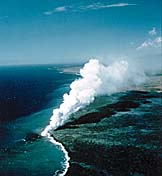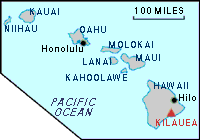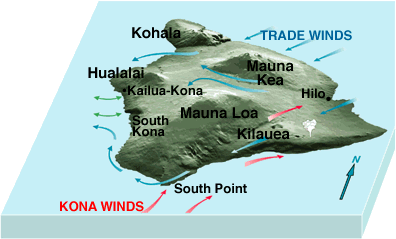
U.S. Geological Survey Fact Sheet 169-97
Online Version 1.1, revised June 2000

U.S. Geological Survey
Fact Sheet 169-97
Online Version 1.1, revised June 2000
| Noxious sulfur dioxide gas and other pollutants emitted from Kilauea Volcano on the Island of Hawai`i react with oxygen and atmospheric moisture to produce volcanic smog (vog) and acid rain. Vog poses a health hazard by aggravating preexisting respiratory ailments, and acid rain damages crops and can leach lead into household water supplies. The U.S. Geological Survey's Hawaiian Volcano Observatory is closely monitoring gas emissions from Kilauea and working with health professionals and local officials to better understand volcanic air pollution and to enhance public awareness of this hazard. |
On the morning of February 8, 2000, Harry Kim, Director of Hawai`i County Civil Defense, asked radio stations on the Island of Hawai`i to broadcast a special message concerning the thick, acrid haze that had covered the southeastern part of the island for several days. Listeners were told that outdoor activities in parks might be canceled in affected areas and that schools might need to keep children indoors. People were also warned to be aware of respiratory problems, as these conditions could deteriorate more rapidly in areas of heavier haze. This choking haze was not caused by a forest fire or industrial pollution but by light winds blowing gas emissions from Kilauea Volcano into the area.

|

|
| Kilauea Volcano on the Island of Hawai`i emits about 2,000 tons of sulfur dioxide (SO2) gas each day during periods of sustained eruption. Air pollution caused by sulfur dioxide and other volcanic gases became a frequent problem on the island in mid-1986, when the volcano's ongoing eruption, which began in 1983, changed from episodes of spectacular lava fountaining (shown here) to a nearly constant but quiet outflow of lava and gas. Left: U.S. Geological Survey scientists sampling volcanic gases from Kilauea. | |
Best known for its spectacular lava fountains and flows, Kilauea also emits about 2,000 tons of irritating sulfur dioxide gas (SO2) gas each day during periods of sustained eruption. Deep inside the volcano, where pressure is high, the SO2 is dissolved in molten rock (magma). When the magma rises toward the surface, where pressure is lower, the gas bubbles out and escapes.
Air pollution caused by SO2 and other gases emitted from Kilauea became a frequent problem on the Island of Hawai`i in 1986. Until that time, the volcano's ongoing eruption, which began in 1983, consisted of short, spectacular episodes of lava fountaining about once every 3 weeks. Since mid-1986, the flow of magma to the surface has been more steady, producing a nearly constant but quiet outflow of lava and gas. People in areas downwind of the volcano began reporting a wide range of problems, including reduced visibility, health complaints, and damage to crops. The word "vog," an abbreviation for volcanic smog, was coined to identify this form of air pollution, which unfortunately has become a part of everyday life for people in Hawai`i.
Vog is created when SO2 and other volcanic gases combine and interact chemically in the atmosphere with oxygen, moisture, dust, and sunlight over periods of minutes to days. Vog is a visible haze consisting of gas plus a suspended mixture of tiny liquid and solid particles, called aerosol. The aerosol in vog is composed primarily of sulfuric acid and other sulfate compounds. Small amounts of several toxic metals, including selenium, mercury, arsenic, and iridium, have also been found in the volcanic air pollution coming from Kilauea. Far away from the volcano, such as along the Kona coast on the Island of Hawaii's west side, aerosol particles dominate vog, but near Kilauea SO2 gas is a major component of vog.
| Sulfur dioxide gas and other pollutants emitted from Kilauea Volcano interact chemically with atmospheric moisture, oxygen, dust, and sunlight to produce volcanic smog (vog) and acid rain. Vog poses a health hazard by aggravating preexisting respiratory ailments, reduces driving visibility (top), and damages crops (lower left), and acid rain can leach lead from rainwater catchment systems (lower right) into household water supplies. |
|
|
|
|
SO2 is a poisonous gas that irritates skin and the tissues and mucous membranes of the eyes, nose, and throat. During even moderate physical activity, SO2 penetrates deeply into the airway and can produce respiratory distress in some individuals. In the absence of strong winds, SO2 emitted by Kilauea can accumulate in the air and reach levels that exceed Federal health standards. Since 1986, this has occurred more than 85 times within Hawai`i Volcanoes National Park, which includes much of Kilauea.
Because of their small size, aerosol particles such as those in vog penetrate deep into the human lung and are readily retained. Studies of air pollution in the United States and elsewhere indicate that elevated levels of acidic particles like those in vog can induce asthma attacks, especially in adolescents, and can also impede the ability of the upper respiratory tract to remove other potentially harmful particles.
Many residents and visitors on the Island of Hawai`i report physical complaints associated with vog exposure. These complaints include headaches, breathing difficulties, increased susceptibility to respiratory ailments, watery eyes, sore throat, flu-like symptoms, and a general lack of energy. In contrast to SO2 gas concentration near Kilauea, the amount of aerosol particles in Hawaii's air does not routinely exceed Federal standards, but the unique combination of acidic particles, trace amounts of toxic metals, and SO2 gas in vog may account for the wide variety of physical symptoms reported.

|
Molten lava from Kilauea Volcano frequently flows through underground lava tubes to reach the Pacific Ocean, where it vigorously reacts with cold seawater to create large steam plumes laden with hydrochloric acid. These plumes, known as "laze", are another form of volcanic air pollution and pose a local environmental hazard along the Island of Hawaii's southeast coast, especially to people who visit these ocean-entry sites. |
Like smog, the presence of vog reduces visibility. Moisture in the air causes vog particles to enlarge, decreasing visibility still further. On the Island of Hawai`i, people often turn their headlights on during daylight hours when driving in vog, and vog sometimes limits visibility for air traffic.
The tiny sulfuric acid droplets in vog have the corrosive properties of dilute battery acid. When atmospheric moisture is abundant, these droplets combine with it and fall as acid rain, damaging plants and accelerating the rusting of metal objects such as cars, industrial and farm equipment, and building components. However, in drier conditions, such as those that prevail on Hawaii's Kona coast, the acid aerosols in vog may actually impede the formation of raindrops, resulting in decreased summer rainfall for crops and drinking water. Vog can also mix directly with moisture on the leaves of plants and in less than a day cause severe chemical burns. Farmers on the Island of Hawai`i have suffered losses even to crops in greenhouses, because vog can enter through the air vents.
Many homes on the Island of Hawai`i rely on rooftop rainwater-catchment systems to provide their drinking water. In 1988, the drinking water of nearly 40% of homes using such systems in the Kona Districts of the island was found to be contaminated with lead leached by acid rain from roofing and plumbing materials, such as nails, paint, solder, and metal flashings. Tests confirmed that the blood of some residents of these homes had elevated lead levels, leading to a major island-wide effort to remove lead-bearing materials from rainwater-catchment systems.
|
|

|
| During prevailing trade wind conditions, the nearly constant stream of volcanic smog (vog) produced by Kilauea Volcano on the Island of Hawai`i is blown to the southwest and west (satellite image shows increasing amounts of vog aerosol particles in yellow, orange, and red, respectively); traces have been detected as far away as Johnston Island, 1,000 miles to the southwest. On the Island of Hawai`i, the trade winds (blue arrows) blow the vog from its main source on the volcano (white plume) to the southwest, where wind patterns send it up the island's Kona coast. Here, it becomes trapped by daytime (onshore) and nighttime (offshore) sea breezes (double-headed arrows). In contrast, when light "kona" winds (red arrows) blow, much of the vog is concentrated on the eastern side of the island, but some can even reach Oahu, more than 200 miles to the northwest. (The names of the five volcanoes that make up the Island of Hawai`i are shown in yellow. National Oceanic and Atmospheric Administration (NOAA) satellite image processed by John Porter and collected by Pierre Flament, University of Hawai`i.) | |

|
|
Much is still unknown about vog's composition and its effects on health. To better understand and evaluate the hazards posed by vog and other forms of volcanic air pollution, scientists from the U.S. Geological Survey's (USGS) Hawaiian Volcano Observatory (HVO) at the summit of Kilauea closely monitor the amount and composition of gas emissions from the volcano's ongoing eruption. In addition, HVO collects and integrates information on volcanic air pollution from other sources and advises scientific and health-care organizations studying its effects. HVO scientists are also working closely with government officials and health professionals in Hawai`i to inform residents and visitors about this hazard.
The studies of volcanic air pollution carried out at HVO by scientists with the USGS Volcano Hazards Programs complement the observatory's other studies of Hawaii's volcanoes. The work of HVO is part of the ongoing USGS effort to help protect people's lives and property from volcano hazards in all of the volcanic regions of the United States, including Hawai`i, Alaska, Wyoming, California, and the Pacific Northwest.
Jeff Sutton, Tamar Elias, James W. Hendley II, and Peter H. Stauffer
Graphics by Susan Mayfield and Sara Boore
Banner design by Bobbie Myers
Web design and layout by Carolyn Donlin
For more information or paper copies of this fact sheet contact:
Hawaiian Volcano Observatory
P.O. Box 51
Hawai`i Volcanoes National Park, HI 96718
Tel: (808) 967-7328; Fax: (808) 967-8890
Also, visit the Hawaiian Volcano Observatory on the Web.
COOPERATING ORGANIZATIONS
American Lung Association of Hawai`i
Hawai`i County Civil Defense
Hawai`i State Department of Health
National Centers for Disease Control and Prevention
National Oceanic and Atmospheric Administration
National Park Service
University of Hawaii, Center for the Study of Active Volcanoes
University of Hawai`i, School of Ocean and Earth Science and Technology
Related Fact Sheets
Living On Active Volcanoes–The Island of Hawai`i (USGS Fact Sheet 074-97)
Explosive Eruptions at Kilauea Volcano, Hawai`i? (USGS Fact Sheet 132-98)
What Are Volcano Hazards? (USGS Fact Sheet 002-97)
See a list of other volcano-related fact sheets published by the U.S. Geological Survey
PDF version of this fact sheet (1.4 MB)
U.S. GEOLOGICAL SURVEY–REDUCING THE RISK FROM VOLCANO HAZARDS
Learn more about volcanoes and the hazards they pose at the USGS Volcano Hazards Program website